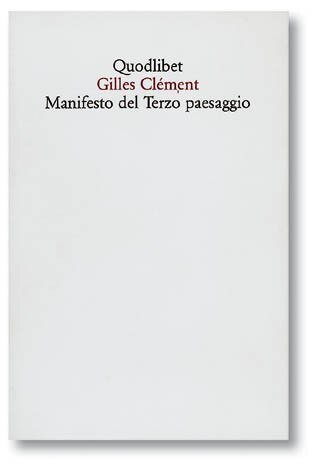Manifesto del Terzo Paesaggio, Gilles Clément Quodlibet, Macerata 2005 (pp. 92, Euro 12,00)
Plants that vegetate in hostile conditions, appear unannounced, grow more than expected and then die in one place only to reappear a few metres away have always been a key figure of the métis: sharp metaphors that are far removed from the linear, predictable and appeasing rationale of much Modernist thought. In this little book by Gilles Clément, a landscapist of the Ecole Nationale Superiéure pour le Paysage in Versailles, plants are real aids to observation, visibly showing change and serving as prompts for reflections on the landscape, actions and aesthetics.
1. The landscape first and foremost. An interstitial landscape that Clément calls the Third Landscape, meaning what is neither light nor shadow: the remainder, separate both from the spaces never exploited (“primary ensembles”), and the protected spaces of human activity (“reserves”). A fragmentary Territory, imbued with great symbolic value but nevertheless residual, undecided, suspended. True friche that clearly highlights the flaws in the logic of the appropriation, inclusion, specialisation and exploitation of space. A place of refuge for natural diversity (to which we usually attribute the same, if not greater, importance as the social differences that are showing signs of suffering in today’s urban environments). Clément’s text is constructed around spaces of this kind; it is divided into short chapters that retrace the origins of the Third Landscape, its extension, character, statute, challenges, mobility, evolution, scale, limitations and its relationship with time, society and culture. These are the 12 sections into which the Manifesto proper is organised, like the argumentation that precedes it. Within an assertive language reminiscent of another famous Manifesto, collettaneo, from a few years ago (Mouvance. Cinquante mots pour le paysage, Paris, 1999), the Third Landscape is change, vitalism, constant shifting for subsequent adaptations, which alternate shock Darwinian moments and slow Lamarck moments. Mouvance is the affirmation of a biological order.
2. Acting on the Third Landscape is going with, not against nature, complying, observing and intervening as little as possible. Avoiding the regulations and remaining indifferent. Avoiding the assumption of wanting to create models. The game of leaving things as they are (and as they evolve) does not, of course, avoid a decision. The action is there and it is traditional, wise, calling the skills of observation, classification and deduction into play. It is that of the scientist, not of the DIY enthusiast, although in this case you start from what is already there and try to turn circumstances into opportunities. The gardener, however, observes and gathers experience. The garden is a laboratory in the sense of the strictest disciplines, a closed space. Even when planetary, it communicates a sense of the finite (Clément, Le jardin planétaire, Paris, 2000). As noted by Maria Valeria Mininni, the expanded microcosm of the garden is where a different concept of nature planted solidly in contemporary times takes firm root. It is no longer autistic heterotopia, that other place in the weave of the modern city. Nor is it the prerepresentation of a possible city, a utopia and the symbolic form of a balance, the place in which to develop ideas on the urban. These two forms, heterotopia and utopia, have constructed a major bond between garden and city, on which some urbanists (e.g. Bernardo Secchi) have insisted. Here the plan is reversed. The city fades and the friches come to the fore.
3. Form. The garden is not a legacy: a further radical disalignment from urban thought. It is not something that can be handed down, and is of value for this reason. Nor does it require an aesthetic approach in the commonest sense, but rather an aesthetic bound to science (the afterword on this) that plays nonetheless with the décalage, the change in scale, the surprise. Challenging Dadaism and leaving the harsh concepts far behind it, highlighted against a background (Mininni) of green belt, fingers, green hearts, with which people worked, throughout the 1990s at least, drawing them back from remote experiences and readapting them to the most recent concerns of a planning that should be sensitive to the landscape. Gilles
Clément’s books are certainly interesting and go well with the increasingly manifest attention (also in the form of translations and publications) of texts that have mostly developed within the field of French experience. They are interesting for their ability to reposition, gather and relay “in their own way” (and hence with as astute an attitude as that of the plants dear to him) ideas that are transmigrating into different fields of knowledge. Appreciation of the remaining social, interstitial and subversive spaces of the economic and symbolic orders has been present for some time in social study traditions. Rediscovering it in an ecological thought – where it is easier to slip into dogmatism - can only make the game more fascinating. This is one of those books that because of its sophistication invites readers to explore its margins: the territories of reflection that are, to borrow the terms proposed here, neither light nor shadow.
The rigid meaning of the notion of regulation, for instance. Or the statute of the Third Landscape as a shared piece of a collective conscience. But also an iconographic language so close to that of Functionalist urbanistics, which is conceptually very distant. It is also a book that has its delaissé territories: places to which another knowledge has recanted, that today appear less controlled and, as such, are opportunities to develop thought. Basically, Clément invites us to rediscover them.
Cristina Bianchetti Professor of Urbanism in Turin


